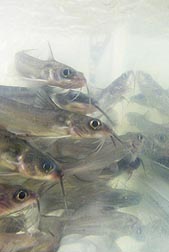| Read the magazine story to find out more. |
|
|
|
|
Using Clay to Fight Fish Disease
By Sandra Avant
January 14, 2015
U.S. Department of Agriculture (USDA) scientists have unearthed a natural material that helps prevent a deadly fish disease.
Kaolin, a type of clay found globally, significantly improved the survival of channel catfish with columnaris disease in a recent study conducted by fish physiologist Benjamin Beck, located at the Agricultural Research Service (ARS) Harry K. Dupree Stuttgart National Aquaculture Research Center in Stuttgart, Arkansas. ARS is USDA’s principal intramural scientific research agency, and this research supports the USDA priority of promoting international food security.
The soft white clay has been used for years in cosmetics, medicine and papermaking. It is also used in manufacturing china, porcelain and other products.
Beck and his ARS colleagues evaluated kaolin as an alternative to antibiotics sometimes used to treat disease in fish. Columnaris affects many commercially grown finfish species worldwide, but few treatments are available to prevent the disease caused by the bacterial pathogen Flavobacterium columnare. The disease affects the gills, skin and fins of fish, and often leads to death.
Experiments involved adding different sizes of clay particles to tanks of water that contained young catfish and then adding the disease-causing pathogen. Some tanks received no clay treatment.
Fish in tanks treated with kaolin had a 96 percent survival rate compared to untreated fish, which had a 79 percent survival rate. Treated fish had no lesions on their gills compared to untreated fish.
According to Beck, kaolin works by binding to the pathogen, preventing it from attaching to the fish and causing disease. The process potentially can be scaled up for commercial production to reduce the amount of pathogen in the water.
Kaolin not only offers producers an alternative to antibiotics, but it also provides an inexpensive treatment for a costly fish disease. In addition, the clay is plentiful, and the United States is one of its leading producers.
Read more about this research in the January 2015 issue of Agricultural Research magazine.

